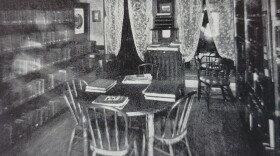The brain child of Franklin Delano Roosevelt’s New Deal, the CCC was spurred on by soaring unemployment rates of 25 percent and the hard times caused by the Great Depression. In 1933, federal entities like the Department of Labor enlisted young men between the ages of 18-25, and later expanded to 17-28. The men served in camps run by the War Department, under the guidance of the Department of the Interior and Agriculture, with a special roll played by State and Federal Forestry Departments. Never before or since have so many federal departments worked together so well to improve America’s public lands forests and parks.
CCC enrollees were sent to the Midwest from all over the country. When they arrived, they underwent training at Camp Sheridan in Chicago. Then, they were shipped out to work in camps in the Sparta District of the 6th Corps Area, including 128 camps in Wisconsin. In the Northwoods, major CCC camps were set up in Tomahawk, Mercer, which just put in an interpretive history trail at the old camp, Blue Lake just south of Minocqua, Rib Mountain, Scott Lake near Three Lakes, Blackwell near Laona, and Elcho, among others. Sub-camps were also used, such as one located just west of Rhinelander on Hwy K, now the current site of the Experimental Forest Research Northern Station.
The young men lived in army barracks in camps run by the military. Enrollees enlisted for 6-month periods and were paid $30 per month. $25 of that pay was sent home directly to their families. This stimulus helped millions of Americans survive the lean years of the 1930s and gave a much needed shot in the arm to the American economy. The CCC worked stringing phone and electrical lines, improving landscapes and waterways, building state and national parks, fighting forest fires, among a myriad of conservation efforts. More then anything, they planted trees. The CCC planted over 265 million trees in Wisconsin, totaling more than 3 billion across the country.
The CCC was instrumental in replanting areas of northern Wisconsin that had been devastated by the logging era just several decades earlier. The CCC did a lot of work in what became the Chequamegon -Nicolet National Forest in the northern area. And it improved state and county parks including Rib Mountain State Park and Dells of the Eau Claire County Park in the north central region.
The CCC was disbanded in 1942 as the United States prepared to enter World War 2. America was fortunate to have a well conditioned group of military aged men at the ready thanks in large part to the work of the CCC. The camps were dismantled and, in many places, little was left except the pine trees that were planted over them. But the important work of the CCC can still be seen in the Northwoods to this day in its parks and forests. Work of the CCC’s counterpart programs like the Works Progress Administration can also be found in the Northwoods such as the bathhouse located at Rhinelander’s Hodag Park, but that, is another story for another time perhaps.
The legacy of the Civilian Conservation Corps is well documented and has been well preserved. Rhinelander’s Pioneer Park Historical Complex has one of the best CCC museums in the nation with one of the most complete collections of CCC photographs, documents, artifacts and equipment in the state. The work of the CCC can be viewed at this museum, housed in a replica CCC camp building. It is open annually Memorial Day Weekend through September.









